Keeping your pets and their homes clean and hygienic is one of the best ways to prevent illness or distress. It’s obvious when your guinea pig is happy and in good health, as they will be running, playing, chattering and acting as they usually do. However, if your guinea pig seems to be under the weather, but a trip to the vet has identified no underlying problems, this could be a sign that better hygiene is required. Here are 5 guinea pig care tips, so that you can be on your way to helping your cavies!
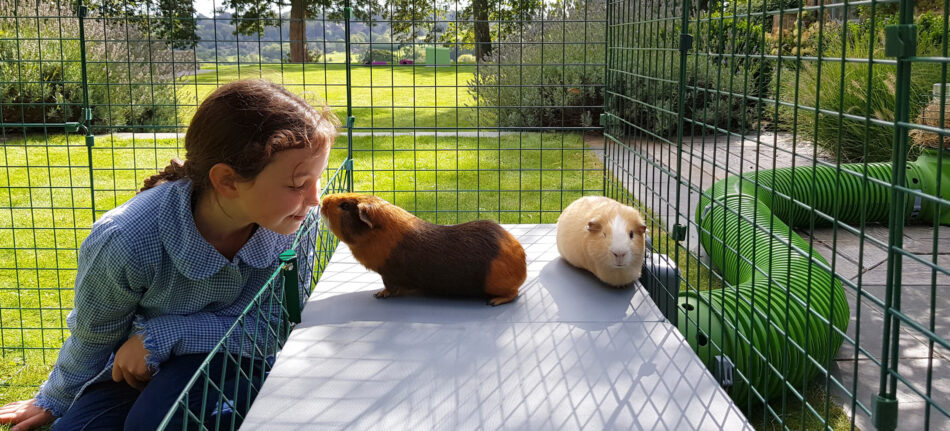
1. Avoid frequent bath time!
If your guinea pigs’ coats are in need of a good clean, there are some important things to bear in mind. Whilst it might be your first instinct to want to bathe them, this can actually be bad for your guinea pigs’ health. In particular, this can lead to developing dry skin.
Guinea pigs actually maintain a good level of cleanliness through self or group-grooming naturally. If a guinea pig coat becomes matted with dirt, you may need to use a chemical-free wipe to slightly wet the fur, enabling you to clean it thoroughly. If a guinea pig’s coat gets wet in the process of cleaning, make sure they have plenty of blankets and warm toys to surround themselves with afterwards.
However, it’s still a good idea to invest in a grooming kit, especially if your guinea pig lives alone. Therefore, you can take the place of their fellow guinea pigs in maintaining their lovely coats!
2. Keep on top of dental hygiene
If you notice that your guinea pigs’ teeth have grown very long, or they’re having trouble eating, it’s a good idea to check with your vet if any action needs to be taken. You can read more about taking care of guinea pigs’ teeth in this Omlet guide.
3. Trim your guinea pigs’ nails
Similarly, you should keep an eye on your guinea pigs’ toenails. Guinea pig toenails need cutting regularly, to keep up with their care regime. If their nails are white, then it is easier to see the blood vessel, or the quick, running down the centre of their nails. This way, you can trim the tip of the nail and avoid the quick. With darker nails however, it can be more difficult to see this. If in doubt, contact your vet, who will be able to help you out with this procedure.
4. Regularly clean your guinea pigs’ hutch
You may be wondering how to clean a guinea pig’s cage, but it’s pretty simple (especially if you have an Eglu Go Guinea Pig Cage!).
Plastic hutches
A healthy guinea pig is a relatively clean animal that relies heavily on the nature and safety of their habitat. The cage, hutch and enclosure are the best places to start when looking at ways to improve your pets’ environment. Depending on the material your enclosure is made of, you will need specific products to clean it. Using the right sort of cleaner will ensure you get the most out of every home and piece of play equipment you buy for your guinea pig.
If your guinea pigs live in a cage or caged hutch, a pet-safe liquid spray disinfectant is perfect for cleaning the cage and any plastic base or guinea pig play equipment. It’s a good idea to soak the cage in water and let it dry before disinfecting, as this will loosen any large pieces of dirt and allow the spray to do its job! If regular disinfecting isn’t doing the trick and the hutch retains unpleasant odours, try using hutch cleaning granules, which have been specifically designed to eliminate smells from your pet’s home. When it comes to how often you should clean a guinea pig cage, the rule of thumb is that it should be done on a twice-weekly basis. This involves taking all of their bedding out of their sleeping area, emptying and cleaning their food bowl, cleaning their feeding area, replacing all the bedding and replenishing the food. The more guinea pigs you have the more often this will need to be done, as more excretions will be produced and more mess made.
Wooden hutches
If your guinea pigs live in a wooden hutch, you need to disinfect it as you would with a regular cage, and it’s also a good idea to clean it every month or so with hot soapy water and scrub the wooden surfaces. Try to minimize soaking the wood by squeezing out most of the water from your sponge before cleaning. If the hutch contains any fleece liners, these are usually machine washable, and it’s good practice to give them a clean more regularly than you would the rest of the hutch. Regardless of which type of hutch you use, always let it dry thoroughly after cleaning before reintroducing the guinea pigs.
5. Replace your guinea pigs’ equipment
Everything you buy for your guinea pigs has a different lifespan, but it is often a good idea to replace items before they deteriorate completely. A typical pet’s water bottle could last many years without breaking, but replacing it every year or so is a good idea. This is because repeated wear and tear of the plastic bottles can result in the animals ingesting plastic, in small pieces or as micro-plastics in the water itself.
Likewise, if you feel that any piece of equipment is no longer possible to fully clean, even after a thorough attempt, it is a good idea to replace it. Your pet would appreciate having something new to play with. Check out Omlet’s range of guinea pig run accessories that are bound to keep your cavies thoroughly entertained!
Although there is no way to ensure your guinea pigs will always stay healthy, paying attention to their hygiene and nutrition will set your pets up for long and healthy lives. Doing plenty of research on your guinea pigs is one of the best things you can do as a pet owner. For example, guinea pigs need lots of vitamin C, and they have been known to lack this essential nutrient in their diets. We’ve even written about why vitamin C is so Important for guinea pigs in a previous blog. They will benefit from the occasional use of supplements.
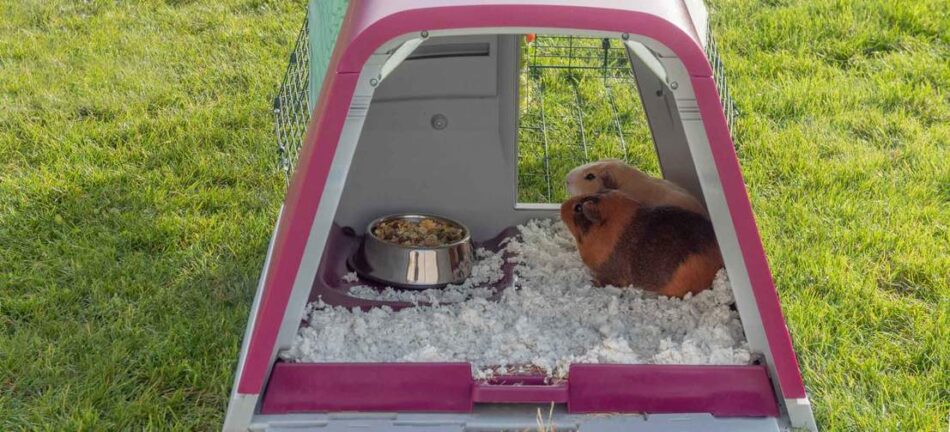
Keeping up to date with the latest advice on guinea pig health has never been easier than on the Omlet Blog, so be sure to keep checking back in for new articles! You can also visit the Omlet website. Where you’ll find guinea pig run accessories, feeders, and hutches that your pets will love!
This entry was posted in Guinea Pigs on June 28th, 2021 by alisa.deluca

If you share your home with a dog, it’s important to make sure the space is just as comfortable, hygienic and safe for them as it is for you. With these 5 dog-friendly interior tips for your home, you can be assured they’re staying safe, whilst your home stays in tip-top condition.
1. Materials matter
This is a simple idea but one that will save you a lot of cleaning time and expense in the long run. Opt for washable sofa covers wherever possible and steer clear of materials that can easily be scratched or will likely attract loose fur. Removing pet hair from your home can be done but it can also be a hassle, especially when it’s partially preventable. Some dogs will need grooming more than others, but brushing your dog regularly will help keep fur off furniture as well.
The same goes for flooring – choose something easy to mop or wipe, especially after a muddy dog walk. A machine-washable dog mattress like our Bolster dog bed will also help to minimize dirt and fur in your home. Simply unzip the cover and machine wash to maintain home hygiene and fresh sheets for Fido.
2. Styling your dog’s bed to your home
Your dog’s bed no longer has to stand out awkwardly in your home. Omlet’s Bolster dog beds are available in 15 bold colours to suit your interior style. Matching the colour of the dog bed to an accent colour in any room can be a great way to integrate their bed with your interior style, and really make it part of the home.
Plus, you can even raise your dog’s bed from the ground for an impressive touch with our range of designer dog bed feet. With the choice of 9 different styles of feet, there’s a dog mattress and feet combination for every home and dog. Curious for more interior styling tips? Find out whether your dog’s bed matches your decor.
3. Dog crate or stylish furniture?
A stylish dog bed needs a stylish dog crate to match. Dog crates are recommended by dog trainers and veterinarians for their many benefits. Not only do they offer a relaxing space for your dog to call their own, but they can also provide comfort and security, especially for puppies and anxious dogs when feeling overwhelmed.
Standard dog crates can be an eyesore in a beautifully decorated home, but we worked to curate a product that doubled as a doggy den and piece of furniture. Introducing the modern Fido Studio dog crate…Available in a Walnut or White design, you can even also an optional wardrobe with a handy storage unit for your dog’s toys and treats (or maybe clothes!). To finish the look, you can seamlessly slide in your Bolster dog bed to create the ultimate hideaway for your four-legged friend and a chic corner in your home.
4. Remove temptation
Most owners of excitable dog breeds will be well-practised in drink-saving reactions to prevent a whipping tail from causing carnage. It’s important to keep breakable or potentially harmful items like candles and glasses up high, not just for your sake but also for your dog’s safety. It’s wise to opt for higher side tables rather than lower-sitting coffee tables for tea and snacks to move the temptation of tasty human treats out of sight.
Dogs that are physically and mentally stimulated are less likely to be destructive in the home as well. Ensure that regardless of your dog’s breed, they’re provided with enriching activities in addition to their daily walks. You can exercise your dog indoors by playing games such as hide and seek, teaching your pup new tricks or even creating an obstacle course using materials you can find around the house.
5. Plants and pets
You can still enjoy house plants and a beautiful backyard when you have a dog but it goes without saying that you should first check they’re not toxic. This isn’t an exhaustive list but the following plants can be dangerous to dogs:
- Aloe vera
- Onion and garlic plants
- Ivy
- Bluebells
- Daffodils
- Grapevine fruits
- Mistletoe
- Holly
There are plenty of plant species that are also dog-friendly, though. These include but are not limited to:
- Magnolia bushes
- Rosemary
- Fennel
- Pansies
- Wheatgrass
- Sunflowers
- Lavender
It’s also worth noting that if your dog loves mud, you might also prefer to keep houseplants up out of reach of digging paws!
Omlet and your dog’s home
With Omlet’s range of dog products such as our easy-to-clean dog beds and stylish dog crates, you can continue to build a wondrous connection between you and Fido, all while your and your dog’s home remains a safe haven and looks great too.
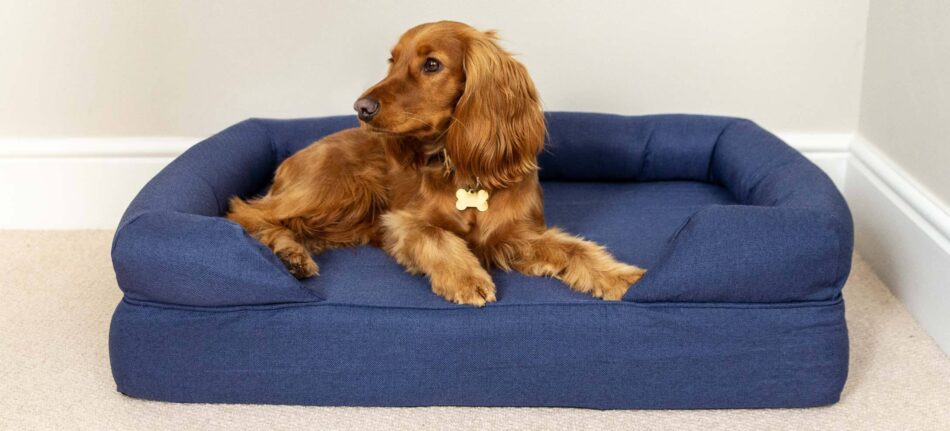
This entry was posted in Dogs on June 20th, 2021 by alisa.deluca

Before introducing new birds to an established flock, they should be quarantined. You will also have to quarantine chickens that have fallen ill or shows signs of illness.
The reason for separating new birds from the established flock is eight parts sensible to two parts paranoia. If you source the new chickens from a reputable supplier or have hatched the birds yourself, there is little chance of the birds harbouring illnesses. However, the potential problems you are guarding against are not easy to spot. Chickens may have internal or external parasites, or the bacteria and viruses that cause disease may be lurking out of sight.
Quarantine significantly lowers the risk of the new chickens spreading parasites or infection in your established flock. In the age of Covid-19, the idea of quarantining has negative associations with isolation and inconvenience. With new chickens, all you’re doing is giving them some space away from the main flock. Other than that, it’s chicken business as usual!
What is quarantine, and when should I quarantine my flock?
Quarantine simply means separating one or more chickens from the rest of the flock. The aim is to minimise the danger of illness spreading between ill and/or new chickens and the existing flock.
All new birds should be put into quarantine. Chickens bought at a show or fair will have been in close proximity with lots of other birds. Chickens from reputable suppliers are not immune to disease either, and even a new-hatched chick may harbour illness, as certain bacteria can penetrate eggshells and infect unhatched birds.
Why do chickens need quarantining?
Bird diseases and parasites spread quickly, and by the time you spot the symptoms, it’s often too late to prevent the other chickens from falling ill. Stressed birds are particularly prone to illness, and a new hen will always be a stressed hen. There’s nothing you can do about this, as it’s a symptom of moving from the world she knew previously to the world of your backyard chickens.
A bird that falls ill needs isolating from the rest of the flock to minimise the risk of the illness spreading. If the issue is parasites – lice, fleas or worms – by the time you spot the problem it will probably be present in every bird, so in these cases, you need to buy the appropriate parasite treatment rather than quarantining single birds.

How long do new chickens need to be quarantined?
New birds should be quarantined for at least four weeks. If there are any illnesses, they will show in the first week, following the stress associated with the move. Give the new birds a thorough health check every few days.
In the final week of quarantine, keepers with a larger existing flock often introduce an older bird – perhaps one that has stopped laying – into the quarantine shed. If at the end of this week the introduced hen is healthy, all is well. If there is any disease lurking unseen, the older bird will begin to look unwell. This is the so-called ‘Canary in the mine’ method, and not everyone will be happy putting an older bird at risk. However, the main point is that you are 90% sure that there is no problem in the quarantined flock by this stage.
Note: bird flu, or avian influenza, has an incubation period of around 21 days, so a hen that was infected on the day you brought her home will not show symptoms for three weeks. This is one of the reasons why the quarantine period is so long.
Setting up a quarantine area for new chickens
There is a simple checklist that gives the quarantine the best chance of being successful:
1. Give the new birds a physical check, looking for signs of lice or fleas. Check the consistency of their droppings and their general posture, referring to our guide to healthy chickens for reference.
2. Make sure the enclosure and coop have everything the new birds need, including a roosting perch, an egg-laying box, fresh food and water, and shelter from the elements.
3. Ensure that no feathers, sawdust, dander, food or water from the quarantined new birds enter the main flock’s enclosure.
4. Don’t wear the same shoes and clothes when tending the healthy and the ill birds. Infection can spread quickly, especially on your hands and the soles of your shoes.
5. The new birds should be kept as far from the other chickens as possible. Ideally, they should be at least 10 metres (33 feet) from the main flock, and downwind as much as possible. However, this will not always be practical, and simply keeping the new chickens in a separate enclosure will be as far as many owners can go. If there is an enclosed building to keep them in, that’s perfect. Keeping the new birds upwind of the existing flock is even more important in these close-proximity set-ups.
What to do if the quarantined chickens fall ill
If any of the new birds become ill, you will need to identify the illness. If you are uncertain, call in expert help to assist with the diagnosis. Depending on the problem, the new chickens will need to be treated and isolated for another month or so. If the illness turns out to be avian flu or another lethal disease, the birds will have to be culled. In the case of the bird flu, check out our bird flu article for the latest advice.
Quarantine of new hens is a better-safe-than-sorry routine that ensures health and happiness in your ever-changing flock of chickens. It also has the advantage of acclimating newcomers to the sights and sounds of your garden before they mingle with the existing flock.
This entry was posted in Chickens on June 16th, 2021 by alisa.deluca
Exercising doesn’t always come easily — in fact, lack of motivation is one of the most common reasons people don’t participate in physical activity. But having a partner to work out with can make all the difference, especially when that partner brings a positive attitude and a wagging tail to the table. Here’s why dogs make great workout buddies, and how you can start exercising with your pup to give you both a healthier leash on life.
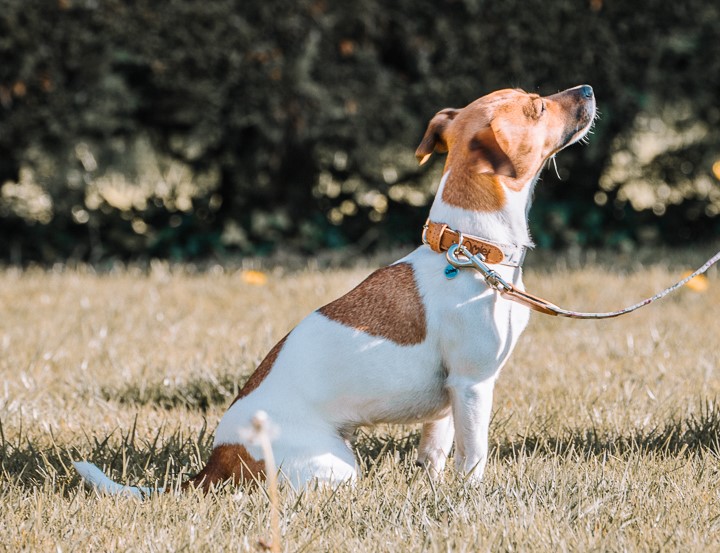
5 Reasons why dogs make great workout buddies
There are several reasons to exercise, and they’re as true for you as they are for your dog. Better physical health, maintaining a healthy weight, and increased mental well-being are just a few benefits that physical activity offers for humans and canines alike. Here’s how you and your dog can keep each other accountable and motivated throughout your healthy lifestyle journey.
1. Dogs are energetic
When’s the last time you saw a human jump for joy at the sight of their running shoes? In contrast, a dog’s reaction to seeing their leash is usually a mixture of unbridled excitement and elation. Depending on the dog, this energy can last anywhere from several minutes to the duration of your workout together, lending you the support and motivation you need to get going.
2. Pups set the pace
Dogs are very good at setting a steady pace. Once they find their stride, you can count on your pup to help set the pace for your workout. Match your cadence to canine’s, and find a familiar rhythm in the wag of their tail or the pattern of their panting. This natural soundtrack to your workout is soothing and motivating, and gives you a focal point if you start to lose steam.
3. Safety in numbers
Running or walking alone isn’t just dull, it can be dangerous. Depending on when and where you do your workouts, there can be concerns of various types. The presence of your pup can provide peace of mind, as their ears and noses are much more sensitive than a human’s. Your dog will be able to sense trouble before you do, and will help deter unwanted encounters.
4. Their schedule’s always open
No more waiting for schedules to align with your human workout buddy — your dog is always available. Since your dog is part of your household, your schedules are already in sync with each other, making exercising together even easier. Dogs are also habit-forming animals, so by setting a schedule to workout with them, they’ll come to expect it. Keep their leash in its designated spot, and try to workout at the same time each day. You’ll soon find your pup gravitating toward their leash as your regular exercise time nears to help keep you accountable.
5. Good vibes only
You’ll never hear a complaint or criticism from your canine, only quiet companionship and confidence. The positivity from your pup is often one of the greatest motivators you can find. No more listening to a personal trainer yell instructions to you — let your dog do the barking.
Dog breeds that make the best workout buddies
Exercise benefits all breeds of dogs, but depending on your level of intensity, you may need to modify your workout to your dog’s ability. For example, dogs with short legs like Dachshunds or Corgis won’t be able to run an entire 5k with you, but they can work up to walking one. Similarly, dogs with “smooshed” faces like Pugs, Bulldogs, or Boston Terriers have restricted airways and shouldn’t be pushed to the point of exertion. Puppies and senior dogs also may not be able to keep the pace with you over long distances.
If you’re looking to adopt a dog and want to incorporate them into your active lifestyle, consider these breeds:
High energy, athletic dog breeds
- Australian Shepherds
- Border Collies
- Boxers*
- Dalmatians
- Doberman Pinschers
- English Springer Spaniels
- German Shepherds
- German Shorthair Pointers
- Greyhounds
- Jack Russell Terriers
- Labrador Retrievers
- Siberian Huskies
- Vizslas
- Weimaraners
*Boxers are a brachycephalic breed, which means they are “snub nosed” and more prone to respiratory distress.
Other breeds may be up to the task of exercising with you, including mixed or smaller breeds. The most important thing is that your pup has received a clean bill of health from your veterinarian, and that you modify workouts as needed to adjust to their ability.
Exercises to do with your dog
So, you’ve decided to be disciplined with your dog and commit to working out — but what disciplines can dogs join you in? The most common exercises that owners take their dogs along for include running and walking, but there are some other activities you can include your dog in. Consider these dog-friendly workout ideas:
- Hiking
- Swimming*
- Kayaking, rowing, or canoeing*
- Yoga
- Cycling
- Dance
*Make sure your dog is fitted with an approved life jacket during these activities.
If you’re heading outside for a workout, choose a time of day where the temperature is moderate. Never exercise outside with your dog in the middle of the day during the hotter months — this can cause heat exhaustion or even heat stroke in dogs, especially breeds with heavy coats. So what temperature is too hot for your dog? When the real-feel temperature reaches 85°F or higher, it’s best to stick to indoor activities. And be sure to check the pavement with the back of your hand before you set out with your dog — if it’s too hot for your hand, it’s too hot for their paws.
Take plenty of water and offer your dog small sips every 15-20 minutes during activity. Plan their mealtimes at least 2 hours before exercising, and wait at least an hour after a workout to feed them to prevent digestive upset. Be sure to take cleanup bags with you — what goes in, must come out, and exercise often stimulates the intestines.
Omlet and your dogs
There’s nothing quite as sweet as that post-workout nap. Give your pup a comfy dog bed to sink into, or a supportive dog crate to retreat to after their cool down. Offer them nourishment and hydration in stylish dog bowls to help them feel their best, so they’re always ready for adventure. With Omlet, you and your dog can enjoy a lifetime of companionship together — both at home and on the go.
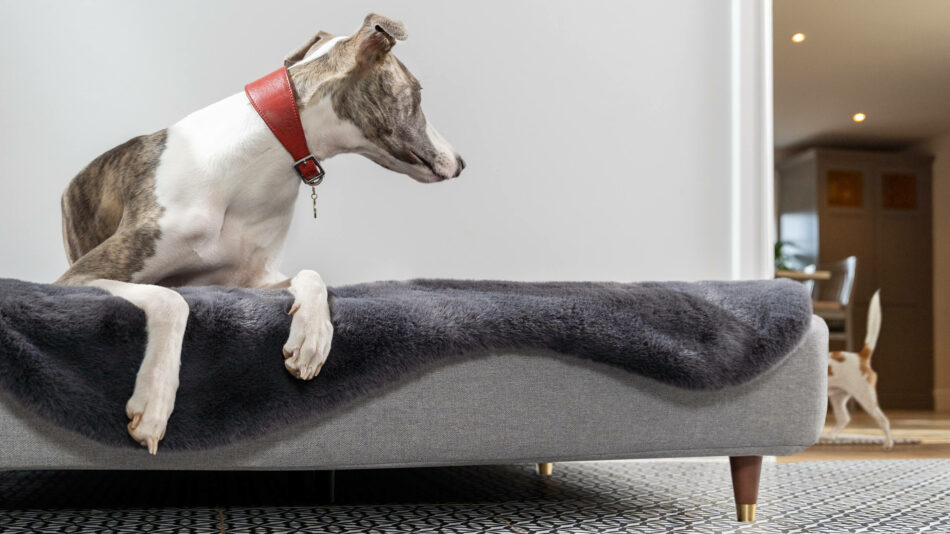

This entry was posted in Dogs on June 10th, 2021 by alisa.deluca
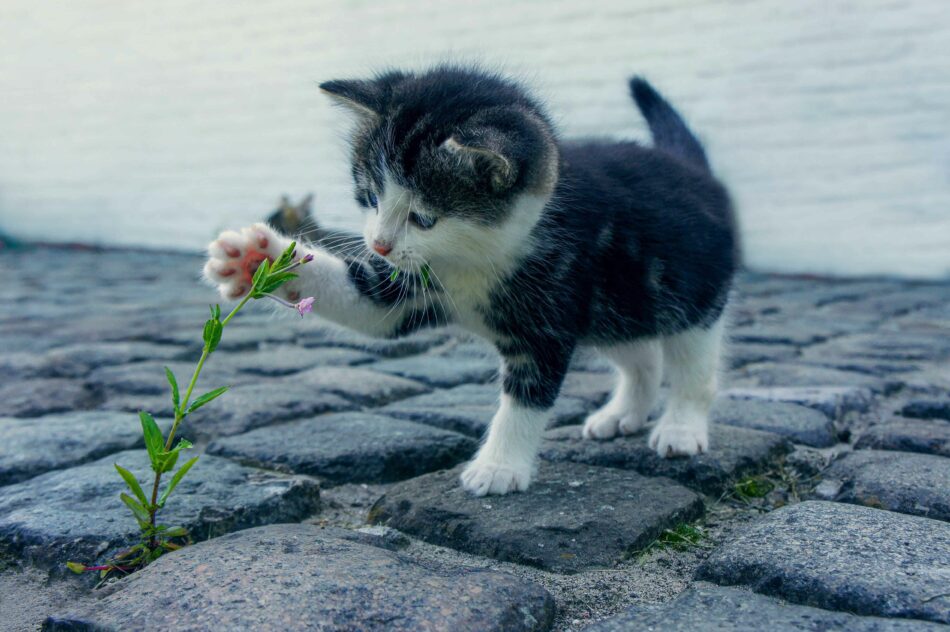
Whether in our gardens or in our homes, plants not only enhance the overall appearance of a space, but they can also help boost moods, increase creativity and reduce stress. But did you know some plants can actually be toxic to your cat if ingested?
While it’s important to know which plants could pose a danger to your furry friend, it is still possible to have green decor and healthy felines coexisting in the same place. So before you forego an indoor nature collection on account of whiskers, browse these 10 cat-friendly plants that are safe for your kitty and look good in your decor.
Why do cats eat plants?
Cats are curious. And just like little children, they often explore new things with their mouths. But if cats are obligate carnivores, or mostly meat eaters, why are they munching on my houseplants? There are several reasons, actually, and it’s best to start with their natural roots.
While most cats are domesticated from the wild, they still possess some innate, instinctual behaviours from their feline ancestors. Eating plants is very common among the cat population and is often something they do to explore textures, help pass a hairball, or even to just increase some nutrient value in their diet. But one of the most common reasons cats eat plants is out of sheer boredom.
You can solve the instinctual desire by only buying cat-friendly plants to keep your cat safe. And having a few sturdy and durable cat scratchers around will help as well. With a cat scratcher like Stak designed by Omlet, you will not only keep boredom at bay, but your cat will be entertained for hours!
10 non-toxic plants for cats
Grasses
If you were to give your cat a grass menu, they would likely choose “clippings from this morning’s mow” or a side helping of “dew-covered sprigs”. When it comes to grasses, most cats are not that picky. But in order to be sure your nursery doesn’t send them to the emergency, stick to harmless grass options such as bluegrass, lemongrass and purple fountain grass.
Ponytail palm plants
Known as the most patient of all houseplants, the ponytail palm plant is both easy to care for and easy on your cat. While it looks (and sounds) like a tropical greenery, this drought-tolerant plant is actually a succulent. In order to maintain its non-needy nature, the ponytail palm stores water in its trunk and produces long curly leaves that look like ponytails. So not only is it safe for your kitty to be around, but it gives your room a calming, tranquil look as well.
Catnip/Nepeta cataria
The only thing your cat loves more than you is catnip. And as luck would have it for you both, this euphoric herb plant is 100% safe for your cat to be around and nibble. Part of the mint family, catnip omits a scent that most cats find simply irresistible. Whether you have it in a planter in the corner or throughout your outdoor garden, cats are wildly attracted to this fragrant plant. In fact, it’s completely normal if you catch your kitty rubbing up against, rolling on or just straight up licking your catnip plant. They literally can’t help it.
Spider plants
When you see a spider in your house, you can usually count on your frisky feline to catch the pesky insect. But what if that spider is on a spider plant? No problem! This cat-friendly plant is completely non-toxic and 100% safe for your kitty to be around. And unlike the legged version, spider plants are easy to care for and simple to maintain.
Prayer plant
If your decor is one that invites a bolder, more colourful style, then a prayer plant may be just the houseplant you, and your cat, need. With striking leaves of striped white and pink colours, these cat-friendly plants are completely safe for your furry friend to be around.
Christmas cactus
While the name may imply that it is only a holiday plant, the Christmas cactus is actually available year-round and is also non-toxic for your cat. More of a succulent than a plant, this feline-friendly cactus produces beautiful pink flowers that are not harmful to your kitty if ingested. And bonus, they add bright colours to your greenery decor.
African violet
One of the most popular flower-blooming houseplants that is also safe for cats is the vibrant African violet. Due to their low maintenance care, many people with, and without, green thumbs like these plants as they add beauty to their space without a lot of requirements. And you can feel at ease knowing the flowers and leaves are not harmful to your cat if nibbled on.
Callisia turtle
This vine-like succulent plant is a great choice for your indoor garden decor as it mystically spills over pots with dense leaves and small white flowers. A unique addition to any home decor, the callisia turtle is also completely feline friendly. In fact, if your cat does eat it, don’t worry – this plant is full of nutrients. Rich in minerals and calcium, the callisia turtle can actually benefit your cat’s digestive system.
Banana tree
Looking to go bigger with your green decor? Then look no further than a banana tree – a dramatic accent plant that is also cat-friendly. The central stems of this tropical plant are often used in human cuisine, so it comes as no surprise that it has also been deemed a safe plant for felines to feast on as well.
Goldenseal
Herb plants are always a great choice when looking for cat-friendly greenery as most are harmless for your cat. Goldenseal sits at the top of the cat-safe list as it’s not only non-toxic but can also be used to treat everyday ailments. Used as a disinfectant for wounds and other sores, goldenseal is known for its soothing and healing properties. In fact, some studies show that, if ingested, goldenseal can help treat ulcers or high blood pressure in your cat as well.
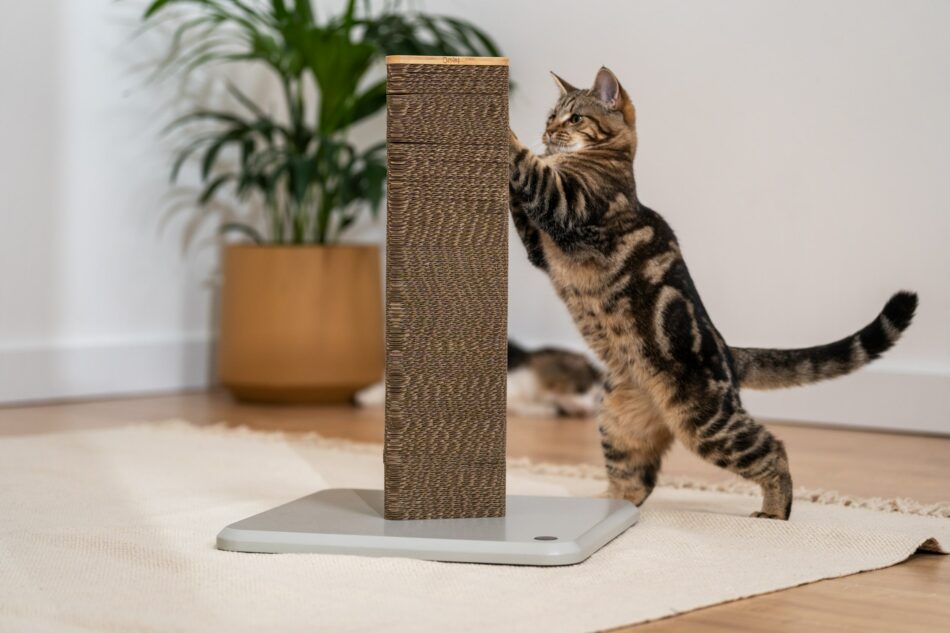
Plants to avoid for your cat
The best defence against your cat’s health is a knowledgeable offence of which houseplants are toxic and potentially dangerous for your furry friend to be around. So if you have a cat in your home, you should be aware of which plants to stay away from to safeguard your cat’s health.
While this list is not exhaustive, some of the more popular indoor and outdoor plants to avoid are: Dieffenbachia, lily of the valley, lily, ficus, azalea, anthurium, daffodil, oleander, holly and mistletoe, poinsettia, yuccas, amaryllis, tulips, and sago palm.
But when purchasing any plants that your cat may be around, it’s best to do your research ahead of time to avoid any doubts or dangers. You can gather information on the internet or consult your vet or the nursery seller for advice as well. And remember, if your cat does ingest or come into contact with any of these toxic plants, you should immediately call or take your cat directly to the vet to seek help.
Omlet and keeping your cat safe
Cats are curious by nature and often unafraid to explore. And while no pet company can stop the inquisitive and common behaviour of plant-eating among cats, we endlessly ask how we can help you both stay safe and happy. With the Stak cat scratcher to end kitty boredom or the Catio outdoor cat enclosure that allows your feline to be in nature safely, we create the products that keep your cat out of trouble.
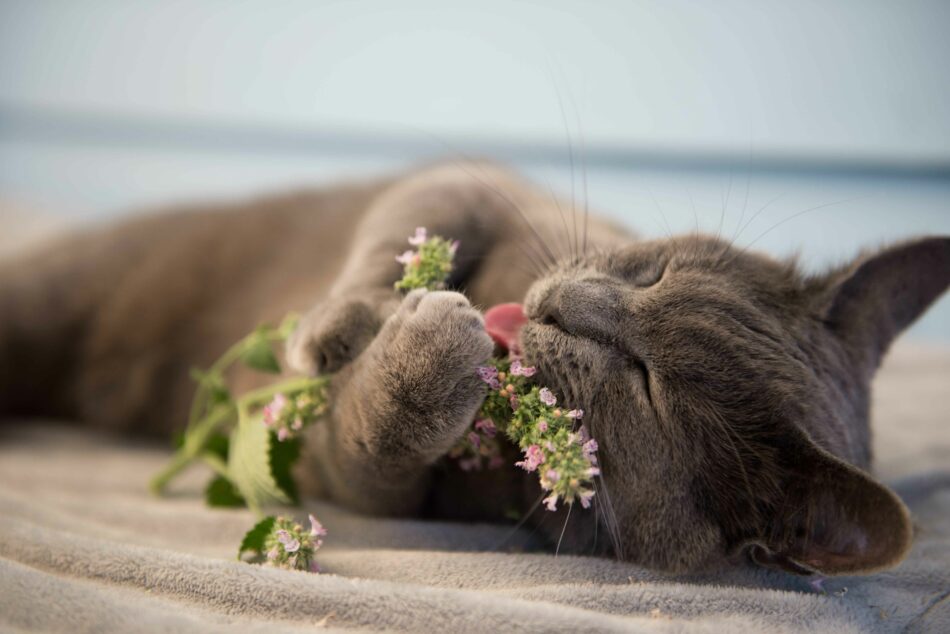
This entry was posted in Cats on June 9th, 2021 by alisa.deluca
There are several reasons why chickens make the best pets for kids. From teaching responsibility, to learning where food comes from, backyard chickens can provide children with valuable life skills and lessons that can’t be replicated by other pets. Discover how adding a flock of hens to your family will broaden the minds of children of all ages, and give them a deeper understanding and appreciation of the wonderful world around them.

Daily chicken care teaches responsibility
Chickens are fairly self-sufficient pets, but they still require some daily care. These tasks are perfect for the young members of your family, and will teach your kids the value and satisfaction of a job well done. The reliance a flock has on their keepers also reinforces the concepts of responsibility and integrity.
Feeding and watering chickens
Feeding chickens is fast and simple, and can be a fun childhood chore. Let your kids measure out chicken feed to add to the flock’s feeder, and allow them to toss chicken scratch as a treat. Chicken waterers can be filled with a garden hose or watering can, which may be a task best suited for older children.
Collecting eggs
Gathering eggs is a favourite activity for adults and children alike. Make sure your hens’ nesting boxes are easy for your children to access, and teach them how to handle eggs carefully to avoid drops or cracks. Let your kids choose their own or decorate an egg-collecting basket to personalise their experience.
Cleaning the chicken coop
An easy to clean chicken coop is a necessity for chicken keepers of all ages, but having a plastic chicken coop that can be sprayed and wiped clean in minutes allows children to get in on the cleaning action. Chicken coops like the Eglu Pro have removable droppings and nesting box trays for easy cleaning, so your children can clean designated coop components during each cleaning session. The sparkling clean results are an instant reward for your children’s efforts.
Opening and closing the chicken coop
Securing chickens at night is a big responsibility, so this should be left to older children — but opening the coop in the morning may be the perfect way for younger children to start their day. Or, if you’re looking to introduce your children to innovative products that streamline tasks, the Smart Autodoor can be accessed and operated via a mobile app from anywhere in the world. Help your children understand the importance of and how to determine your flock’s schedule by talking about time, amount of daylight, and the potential for predators at dawn and dusk.
Handling chickens teaches gentleness and patience
Chickens aren’t hatched with an innate tolerance of being handled. Handling chickens requires gentleness and patience, both of which are excellent lessons for kids to learn and put into practice. If you’re starting with chicks, make sure children understand that chicks are fragile, and if squeezed or dropped may sustain injuries. Regular interaction will help chicks grow accustomed to their young owners, and will build confidence in your children’s chicken-handling abilities.
Fresh eggs are perfect for beginner culinary creations
Children of all ages can learn how eggs are incorporated into different dishes and meals. Young children can crack fresh eggs for scrambled egg breakfasts, while older children can crack them into cake or cookie recipes. For budding chefs, you can help your child try their hand at poached eggs or a frittata, or master the art of making the perfect meringue.
Appreciation for where food comes from
Many children don’t have the opportunity to see where their food comes from. But thanks to the possibility of keeping chickens in even an urban backyard, kids can be exposed to the process of egg production. Teaching children the biological process of laying eggs, the supply and demand of food, and how nutrition benefits the production of hens are all valuable lessons that can be observed in a backyard flock. You can also show your children how to store fresh eggs to reduce waste or to prepare for the lack of eggs during your chickens’ annual moult.
Relaxing back garden companionship
Unless you’ve witnessed it yourself, it’s hard to describe the serenity that comes from watching chickens peck the ground. Children aren’t exempt from this phenomenon, and it’s a sight to behold when your child is happily playing in the backyard surrounded by a flock of gently clucking hens. Your flock will help control pests in your backyard, making it more enjoyable for your children to play in the grass, while also providing calm companionship while your kids play. Have your children bring fresh fruits or vegetables to the flock and watch them become the instant favourite. Children of all ages can delight in hand-feeding their hens fresh, nutritious treats.
Chicken handling hygiene
Always teach your children hygienic chicken handling techniques. When interacting with chickens, keep the following in mind:
- Always wash your hands and teach your children to wash their hands thoroughly after handling eggs, chicks, or chickens, or after cleaning the coop.
- Don’t allow your children to kiss their chicks or chickens. We know it’s tempting, but this well-intended gesture is not worth the risk of illness.
- Contact your veterinarian right away if any of your chickens appear sick.
Omlet, your children, and your flock
As a parent, you want what’s best for your children. And as chicken experts, we design what’s best for flocks and their caretakers — no matter their age. Our chicken coops are easy to access and clean, and our Walk In Chicken Run features stable-style doors for convenient access. And to help your busy schedule, our Smart Autodoor offers automation for your flock’s schedule, without losing the lesson of the importance of securing chickens in their coop overnight. Discover how fun and easy chicken keeping can be, and learn all about these amazing animals along with your children. With Omlet, flock raising can be a truly enjoyable family endeavour.
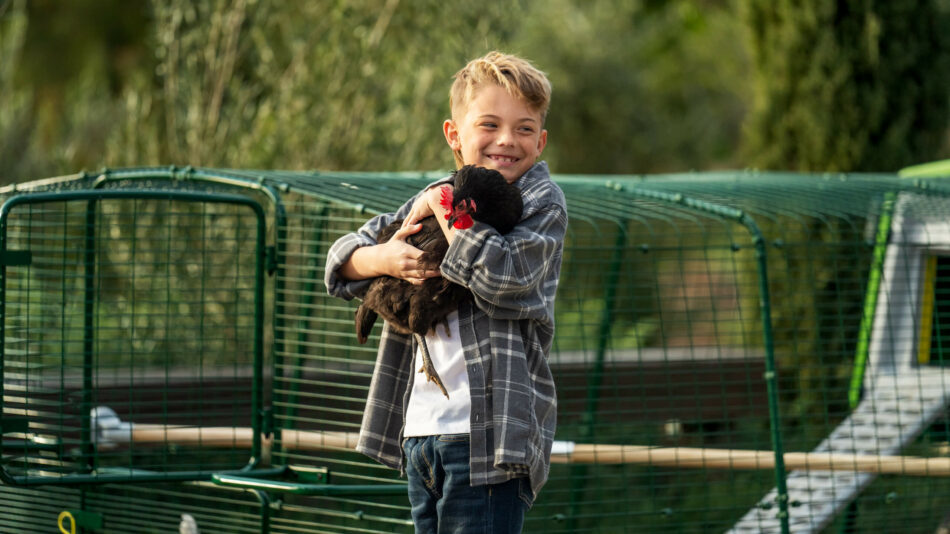

This entry was posted in Chickens on June 8th, 2021 by alisa.deluca
As we head into summer and the weather begins to warm up, you might be wondering how you can help your chickens keep cool in the hotter months. Get prepared now and catch up with our previous blog posts on keeping happy and healthy hens during summer below…
7 Ways to Help Your Chickens Stay Cool This Summer
Did you know, that chickens can’t sweat? Instead, chickens use their legs, combs and wattles to lead heat away from their bodies. They also pant and spread their wings in order to get some air through their feathers. But what can you do to help?
From water to dust baths, here’s 7 simple but effective tips to help your chickens stay cool in the hot weather…
10 Things Not to Do in Summer if You’re a Chicken Keeper
From 7 things you should do, to 10 things you shouldn’t do this summer if you’re a chicken keeper! This advice is just as important as the tips above for ensuring a comfortable environment in the warmer weather, and also preventing your chickens from overheating.
How to Protect Your Chickens from Red Mite
Red mites, or Dermanyssus gallinae, are without a doubt backyard chicken keepers’ worst enemies! They are nocturnal creatures living in cracks and crevices of the coop, and they only come out at night to feed on chicken blood. Most long term chicken keepers will have encountered these parasites, and can confirm that they are more destructive and difficult to get rid of than all other pests combined.
Learn how to treat and prevent red mite infestations in your coop to keep your chickens happy this summer.
How the Eglu Keeps Chickens Cool
Traditionally chicken coops and rabbit hutches have been made from wood. This has its advantages: it’s an easy material to work with, it’s customisable and it looks attractive. However, when it comes to coping with the weather, it can leave a lot to be desired. Wood is not a very good thermal insulator, meaning if it’s hot outside the temperature will transfer through to the inside quickly.
If you’re using a wooden coop, it might be a good time to consider upgrading to a better insulated and ventilated house before the worst of the hot weather hits. Learn how an Eglu keeps chickens cool in this blog post.
This entry was posted in Chickens on June 8th, 2021 by alisa.deluca
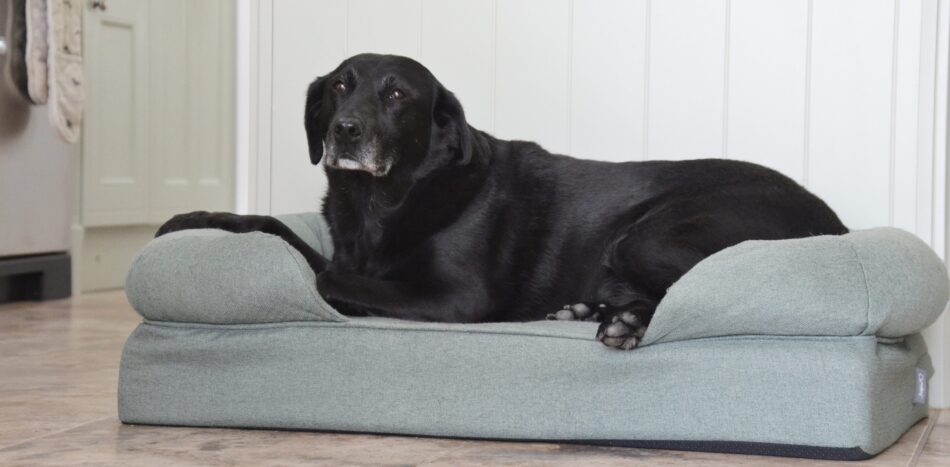
Dogtor™ Adem, Dog behaviourist & trainer, discusses everything you need to know about dog beds, which types may suit which breed and age of dog, and why we might see our four-legged best friends exhibit certain behaviours in and around their beds. Read on to learn more!
What should I look for in a dog bed?
A dog bed should be comfortable for the breed type, age and size of your dog. If you have an older dog, they might benefit from an orthopedic or memory foam bed, such as the Omlet Bolster Bed with premium memory foam mattress, which gives support by gently moulding around your dog. A puppy, on the other hand, might benefit from a bed that can absorb water if, for example, a bowl of water is accidentally knocked over by them or they ‘toilet’ on their bed area whilst still being house trained. For puppies, you may also want to consider a type of bedding that is comfortable for them but not too precious or expensive due to the higher risk of this bedding being chewed or damaged as they play and explore. For me, it is also important to choose a bed that is robust and can be easily washed. Again the Omlet Bolster bed is a great choice with this feature! This not only helps the environment by limiting the need to frequently replace a smelly or very worn dog bed with a new version, but also ensures any accidents or dirt brought into their dog bed area can be easily cleaned away, keeping their bed area hygienic and inviting. You could also consider covering your dog’s bed with a removable and washable cover, particularly in the winter months.
What type of bed might suit my breed of dog?
Certain breeds might need more cushioning than others to stay comfortable and limit their potential for developing sores or sore patches, for example greyhounds who are considered more ‘boney’ than many other breeds. Some breeds might also like to curl up, for example a husky or some of the smaller breeds, whilst others prefer to lay on their side and stretch out, for example hounds such as deer hounds, greyhounds, and lurchers. An owner should consider how their individual dog likes to lay and relax and choose a suitable bed with this in mind.
The time of year can also have an effect on where your dog chooses to sleep. To ensure your dog remains comfortable, you can adapt their bed to suit the season by adding extra blankets or even cool mats to your dog’s bed. If you’re looking for a cozy blanket, Omlet’s Super Soft Dog Blanket is definitely a winner for those cooler months where some dogs might like to ‘snuggle up’. For the warmer months of the year, you could try a cool mat instead of their usual bed if it is particularly hot! Omlet’s Cooling Mat for Dogs is a perfect choice, coming in a range of sizes to suit many breeds.
I have observed my dog ‘digging’ their bed, why is this?
This is a natural instinct derived from the need to ‘clear the ground’ or an area of insects and potentially small rodents and reptiles. Ancestors of our pet dogs might need to do this in order to make the area they are choosing to reside in safe for them to lay down in. Some dogs, such as those in tropical climates that predominantly live outside or live as ‘street dogs’, still use this instinctive behaviour to keep themselves from being bitten and stung. This act of ‘clearing the ground’ may even have benefits in preventing parasite infestation. Whilst in Mauritius last year, I witnessed a young street dog clearing an area and whilst watching I noticed that she stopped in her tracks and became very observant as she had disturbed a small scorpion in some leaves. Without this act of digging and clearing, this dog would have undoubtedly been stung by this scorpion.
Dogs may also dig because they sweat through their paws, making the act of digging and ‘circling’ in an area another way of spreading and leaving their scent. This is something we commonly know as ‘marking’ and usually associate with the image of dogs urinating up lamp posts!
Finally, dogs may also dig naturally on hot days and in hot climates in an attempt to try to remove hot surfaces (e.g. baked earth). This helps them to reveal a cooler surface to reside in. In addition, wild canids such as arctic foxes and wolves, may dig to avoid extreme weather such as high wind, the cold (e.g. snow), and storms. Again, this act helps to keep them safe as well as assists in regulating their body temperature. Although seldom needed in the pet dog world today, this instinctive behaviour still remains in part in our domesticated dogs.
How can I train my dog to sleep in their bed?
A good training instructor or behaviourist will have this on their training syllabus, helping owners to teach the ‘go to bed’ command.
If, however, your dog is reluctant to sleep in their own bed you should investigate why. Firstly consider, is the bed area provided the most attractive sleeping area available to your dog? Positive reinforcement such as offering treats in this area can help to make their bed area a more positive and inviting place to reside, as can ensuring the bed is comfortable for their breed type and age (as discussed above!) Secondly, you might want to evaluate if your dog potentially has a behavioural issue such as separation anxiety that is preventing them from wanting to sleep in their own bed. If you believe this to be the case, you should seek help from a certified behaviourist to address this issue and help to build your dog’s confidence in being physically away from you.
How can I stop my dog destroying their bed?
Think about your dog’s life stage. A young puppy may chew a bed as they explore with their mouth and enjoy the texture on their teething gums. In this instance, it would be advisable to buy a bed that does not contain lots of small parts or stuffing that can be ingested. Similarly, you could pick bedding made of material that can not easily be broken down through the act of chewing. You can always buy a ‘nicer’ bed for your dog to use under your direct supervision until they have passed this life stage and have lost their baby teeth and gained all of their adult teeth.
If your dog is older and destroying their bed, perhaps when they are left alone for example, this could potentially signal that your dog is feeling stressed and is suffering from separation anxiety, for which behavioural advice should be sought to enable your dog to recover from this issue.
Similarly, chewing and destroying of beds can also sometimes indicate that your dog is bored. To combat this, you could look to try to tire your dog more effectively before leaving them alone, which will encourage them to rest more in your absence. You should also ensure that your dog is not left for long periods of time by themselves. Just like us, dogs are social mammals and need company. As well as ensuring your dog is appropriately exercised and is not being left for too long, you can also offer your dog something to do for some of the time you are away from them. For example, you could leave them something else to chew that is safe and made for this purpose. Consider leaving them with a hard chew food item or a food dispensing toy filled with tasty treats for them to try to get to!
I hope you have found the above information useful. Wishing your beautiful pooches the most restful of snoozes!

Dogtor™ Adem
Dog Behaviourist & Trainer
www.dog-ease.co.uk
@dogtoradem
This entry was posted in Dogs on June 7th, 2021 by alisa.deluca
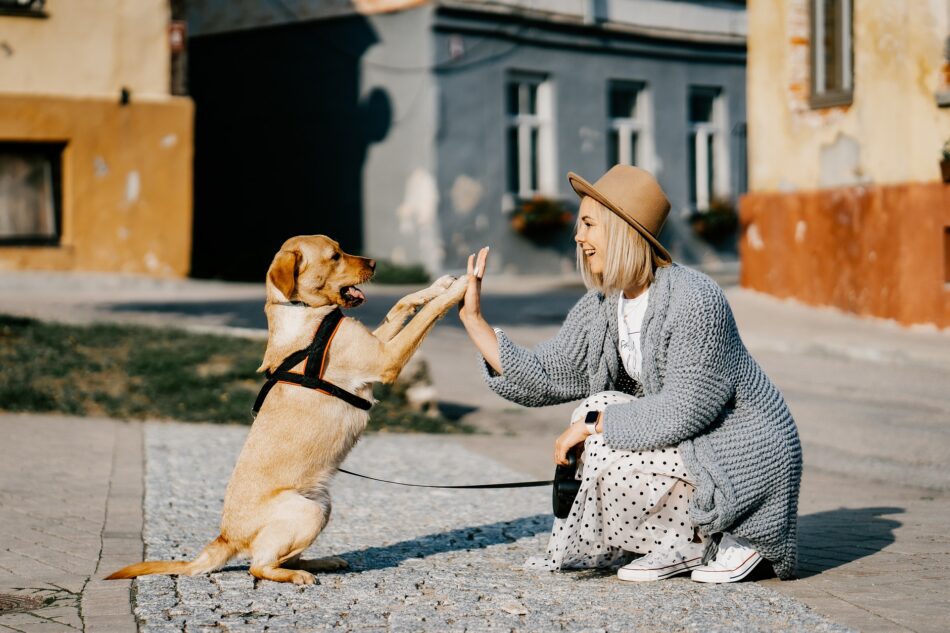 A dog who has been taught positive behaviour will be your best friend – fun, affectionate and reliable. It’s straightforward teaching your dog this canine version of positive thinking, but it won’t happen unless you lead the way.
A dog who has been taught positive behaviour will be your best friend – fun, affectionate and reliable. It’s straightforward teaching your dog this canine version of positive thinking, but it won’t happen unless you lead the way.
There are many ways of teaching a dog the rights and wrongs of living in the human world, and that extends to how they interact with other dogs and the world around them. In this article, we reveal the five rules of thumb for all dog owners – whether you’re training an adult dog or a puppy.
Encouraging Positive Behaviour in Puppies
Puppies recognise when we’re pleased or displeased. It’s all part of their instincts, and in the wild this instinct helped their wolf ancestors find their place in the pack very quickly. Learning their place in the big wide world is all about positive reinforcement.
1. Puppy Treats. Dogs of all ages love food and will put lots of effort into doing what you want them to do as long a there’s a yummy treat at the end of it! This means treat-based training can be used for everything from toilet training to basic obedience training and that all-important early socialisation. The message here is simple and timeless – do this right, and you’ll get a treat!
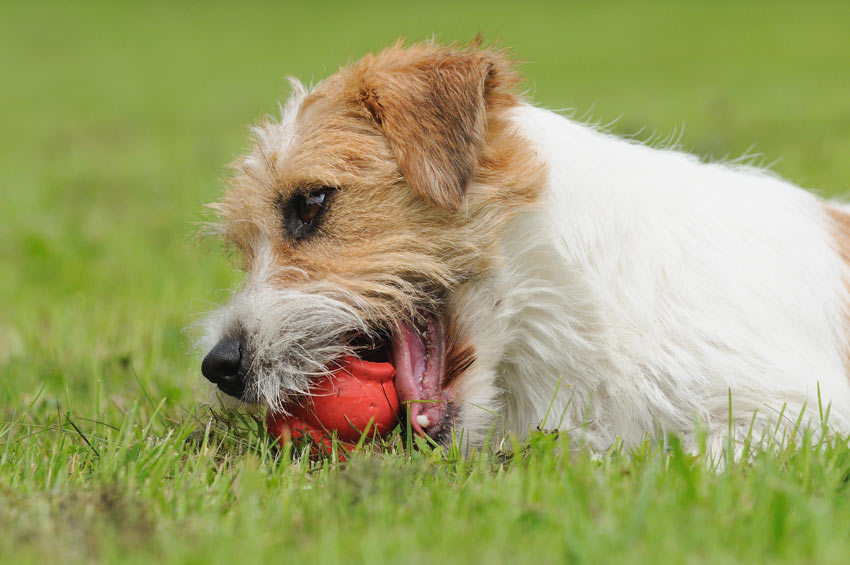 2. Affection. This is arguably even better than a food treat! Bonding with a puppy involves physical contact in the form of belly-rubs, back stroking and lots of gentle words of affection and encouragement.
2. Affection. This is arguably even better than a food treat! Bonding with a puppy involves physical contact in the form of belly-rubs, back stroking and lots of gentle words of affection and encouragement.
3. Fun and games. Tug-of-war, fetch and simply running around the garden with you are games that puppies love. What’s more, they strengthen the bond and love between you and your pet, and that’s the perfect groundwork for training and encouraging positive behaviour.
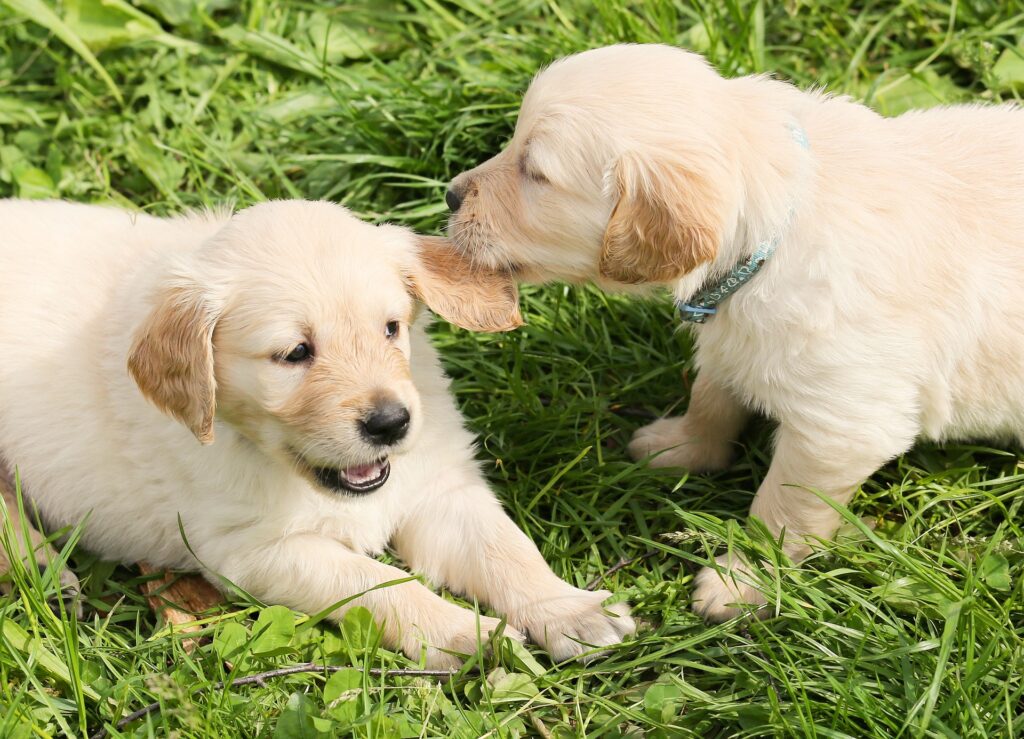 4. A trip to a favourite place. This is a great treat for dogs, and can be as simple as a trip to the park, or perhaps to a favourite street for an on-lead walk, or maybe a shop that sells some of those yummy treats! If this is being done as a reward for good behaviour, make sure your puppy knows it by telling them what a good boy/girl they are as you put the lead on or get into the car!
4. A trip to a favourite place. This is a great treat for dogs, and can be as simple as a trip to the park, or perhaps to a favourite street for an on-lead walk, or maybe a shop that sells some of those yummy treats! If this is being done as a reward for good behaviour, make sure your puppy knows it by telling them what a good boy/girl they are as you put the lead on or get into the car!
5. Puppy playdates. Starting these early is a great way to socialise your puppy, and that provides the basis for all the positive behaviour training. Young dogs love meeting each other – it’s not going to be a quiet morning out with your furry friend, but it’s one that will give him or her essential social skills.
Encouraging Positive Behaviour in Adult Dogs
The basics are simple. Positive reinforcement rewards a dog for good behaviour and ignores, rather than punishes, undesirable behaviour. Punishment will only lead to confusion and fear in your dog, reducing your chances of achieving the full benefits of positive-behaviour training.
Here are the five ways to make everything go smoothly, no matter which dog breed you have.
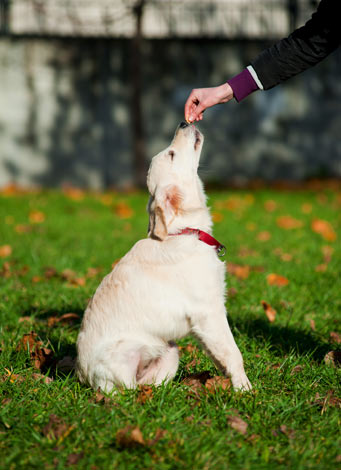 1. Keep it simple. One-word commands are better than complex ones. We’re talking here about sit, come, sat, etc. Save the long-winded exchanges for praise and affection! A training session based on simple commands and treats is a great start for encouraging positive behaviour. Which brings us to…
1. Keep it simple. One-word commands are better than complex ones. We’re talking here about sit, come, sat, etc. Save the long-winded exchanges for praise and affection! A training session based on simple commands and treats is a great start for encouraging positive behaviour. Which brings us to…
2. Treats. Just like puppies, adult dogs will be well and truly ‘reinforced’ if treats are involved. Some breeds are more food-obsessed than others, but all types of dog will quickly learn that good behaviour results – at least in the early days of training – in a yummy treat.
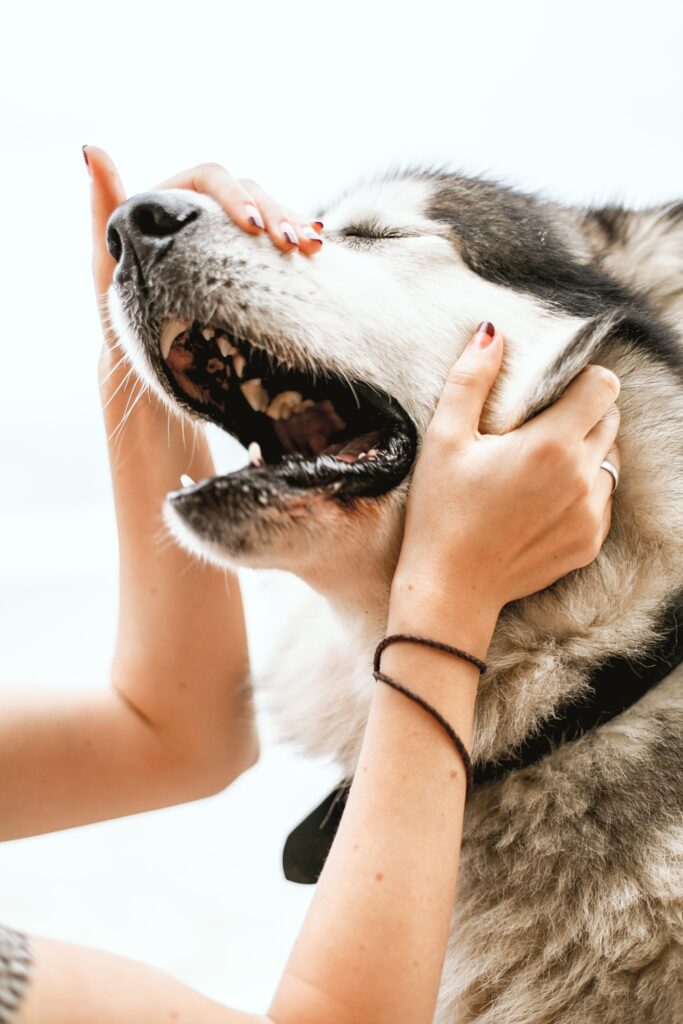 3. Quality time. Dogs are social animals by instinct, and they will thrive in human company. Once you and your pet are the best of friends, the positive behaviour training will be much easier. If there’s any nervousness or standoffishness in your dog, they will be less able to take on board the things you’re trying to teach them. So, keep up the contact, and play with them every day.
3. Quality time. Dogs are social animals by instinct, and they will thrive in human company. Once you and your pet are the best of friends, the positive behaviour training will be much easier. If there’s any nervousness or standoffishness in your dog, they will be less able to take on board the things you’re trying to teach them. So, keep up the contact, and play with them every day.
4. Make it fun. A long session of ‘sit, lie down, stay, come’, etc. will soon become boring for a dog. A short session of command-based training followed by a bit of fun, however, will make your dog look forward to the sessions every time. After five or ten minutes (depending on your dog’s stamina), round off the proceedings with a game or a walk. The dog will soon realise that “If I do this tricky bit, I get that fun bit afterwards!” It’s a trick that works just as well with young children – “Finish your homework, and then we’ll go out on the bikes!”, that kind of thing.
5. Get everyone involved. Once your dog has grasped some of the basics, other members of the family, or friends, can reinforce the good behaviour by running through some of the training with your dog. Your pet will then learn that positive behaviour is part of their general lives and applies in all situations with all people.
This latter point is the ‘quantum leap’ for a dog – the idea that positive behaviour extends beyond their immediate owner to the big wide world around them. Getting them to this point takes time, there’s no doubt about that, and some breeds are a lot easier to train than others. However, once the work has paid off, you’ll have a doggy best friend you can be truly proud of!
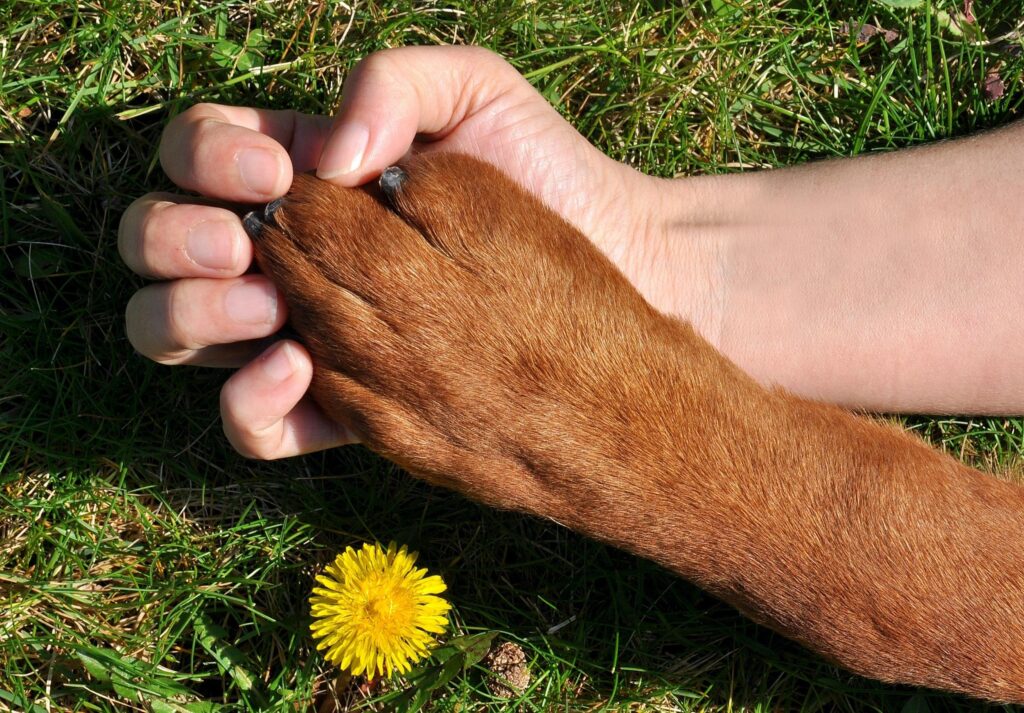
This entry was posted in Dogs on June 7th, 2021 by alisa.deluca
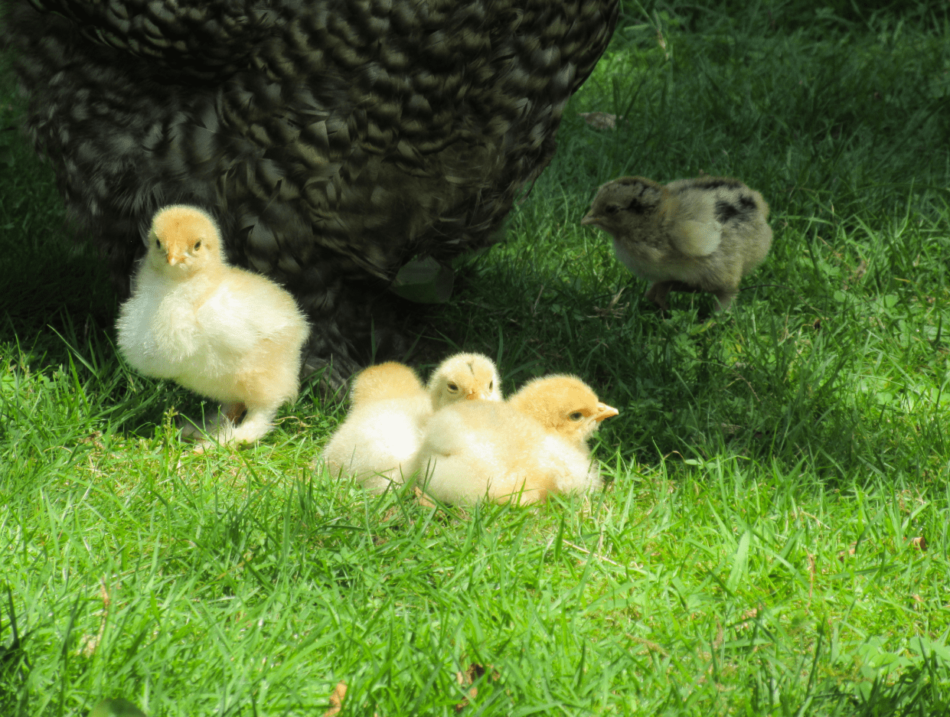
Chickens pretty much take care of themselves from an early age. However, there are certain things you need to avoid if you want your baby chickens to get the very best start in life.
In this article, we present six easily preventable pitfalls.
1. Not having the brooder ready before the chicks arrive
You need to sort out the chicks’ housing – known as a brooder – before the birds arrive. Otherwise, there will be nowhere to put them, and that would be disastrous.
You can buy brooder boxes made specifically to keep chicks in, or you can make a DIY brooder using a cardboard box or plastic bin with holes in the side. Only choose the DIY avenue if you’re 100% confident you know what you’re doing.
The important thing is to keep the birds in a warm and well-ventilated space, but protected from drafts. As a rule of thumb, allow two square feet per chick – this is more than enough space for fluffy newcomers, but remember you will also need to make sure they have enough room when they get bigger – which they will do very quickly!
A chicken wire covering for the top of the brooder is advisable. Chicks can easily ‘fly the nest’ if the sides of the brooder are less than 45cm high. Older chicks need roosting poles for perching when they sleep, and will appreciate the inclusion of these in the brooder.
2. Not getting the temperature right
Too much or too little heat can kill chicks, so this is another life-or-death issue. The chicks need to be kept in a temperature of 35 °C (95 °F) in their first week. The heat should then be reduced slightly every five days or so until you’ve reached room temperature.
The source of heat is an important detail too. A heater designed explicitly for coops and aviaries is the best option, or a red heat bulb. You should not use a white heat bulb, as these produce glare that keeps chicks awake at night. This will make them irritable, as a result of which they may start pecking each other. Standard light bulbs are not suitable either.
Even the correct type of heater or bulb will need some adjusting in terms of where it hangs, and how high it is from the ground. Watch how the chicks behave in relation to the heat source. If they crowd together directly under the bulb or in front of the heater, it means they’re too cold. Lower the heat source or add an additional one, depending on the situation.
If the chicks cluster away from the heat source, they’re probably too hot. In this case, the heater or bulb will need to be moved further away, or its temperature reduced slightly. The chicks’ behaviour may change as they grow larger and the space becomes more crowded, so watch them carefully each day.
3. Using the wrong type of bedding
With chicks, it’s not a case of “any old bedding will do”. Use wood shavings or other non-toxic, absorbent material recommended for baby chickens. Avoid newspaper or shredded magazines, and don’t use aromatic, oily woods such as cedar. A 2.5cm layer of this bedding will be enough. If you omit the bedding, the chicks are in danger of slipping and sliding on the surface, which can lead to an injury called “splayed leg”, which is a life-threatening condition. The bedding should be changed at least once a week to prevent sticky droppings from accumulating.
4. Getting the wrong type of feed
Starter feed – in the form of either ‘crumble’ or ‘mash’ – is the essential basis of a chick’s diet. If your chicks have been vaccinated against coccidiosis, you will need to buy an unmedicated feed. The starter feed will double as a ‘grower’ feed, intended for chicks for up to 16 weeks. Some varieties, however, are for the first four weeks only, after which you can switch to a ‘grower’ feed.
Chicks will also enjoy a bit of fresh food as a treat, either vegetables or worms and bugs. These should never replace the starter feed mix, however. Chicks only eat as much as they need, and there’s no danger of them over-eating. So all you have to do is make sure the feeders are topped up at all times.
Like adult birds, chicks require grit to grind up their food. It needs to be sand grain-sized rather than the small pebbles and shell fragments that grown birds require.
The chicks will need food and water dispensers. Buy custom-made ones rather than improvising with dishes and trays: these inevitably end up fouled and/or spilt. Very young chicks will need to have their water changed at least twice a day, as they very quickly dirty it.
5. Forgetting to perform daily health checks
A chick health check is a simple case of looking at the young birds and making sure they look as lively and alert as usual. A chick that sits alone and looks lethargic or fluffed up when the others are active may be unwell. An ill chick will deteriorate very quickly and die.
The most frequent health issue encountered in young chicks is ‘pasting up’. This is when their droppings become encrusted on their bodies, preventing them from pooping. An affected bird can be cured by wetting the pasted-up area with warm water and wiping it clean. You may occasionally have to use tweezers to remove a plug of poo from the vent. The chick will need holding securely during this rather delicate and undignified procedure. If left blocked, a pasted-up chick could quickly die.
Note: if there is a thin dark strand hanging from a chick’s rear end, this is NOT pasting up. It’s the dried up umbilical cord that attaches the bird to its yolk inside the egg. It will fall off in a few days.
6. Moving chicks outdoors too quickly
Chicks can spend up to three hours a day outdoors once they’ve reached two weeks, as long as there is someone to supervise them. A large wire cage or portable run will do the job. The birds should only be placed outside if it’s at least 18 °C (65 °F), dry and not too windy. They will need food, water and shade.
Note: If you take the chicks outdoors before two weeks old, or if you leave them for more than three hours, they may catch a chill or sunstroke (depending on the prevailing weather). These shocks to the system can kill a small bird.
By 12 weeks, the young hens are old enough to move into an Eglu chicken coop and run. They will still be too small to negotiate the roosting bars, so these should be removed until the chicks are big enough to perch and walk across them safely. If you have an Eglu Cube Chicken Coop, the chicks may have to be lifted in and out of the roosting and laying area, as they often struggle with the ladder. This can be converted into a ramp during these early weeks, to make things easier for the hens.
The roosting area of the Eglu – or any other walk-in coop and run set up – should have lots of chicken bedding to ensure the hens stay warm at night. The bedding should also be replaced at least twice a week.
Chicks soon pick up the dos and don’ts of life from your other birds. A lot of their behaviour, remember, is based on instinct, so as long as you give them the right environment, nature will take care of the rest.
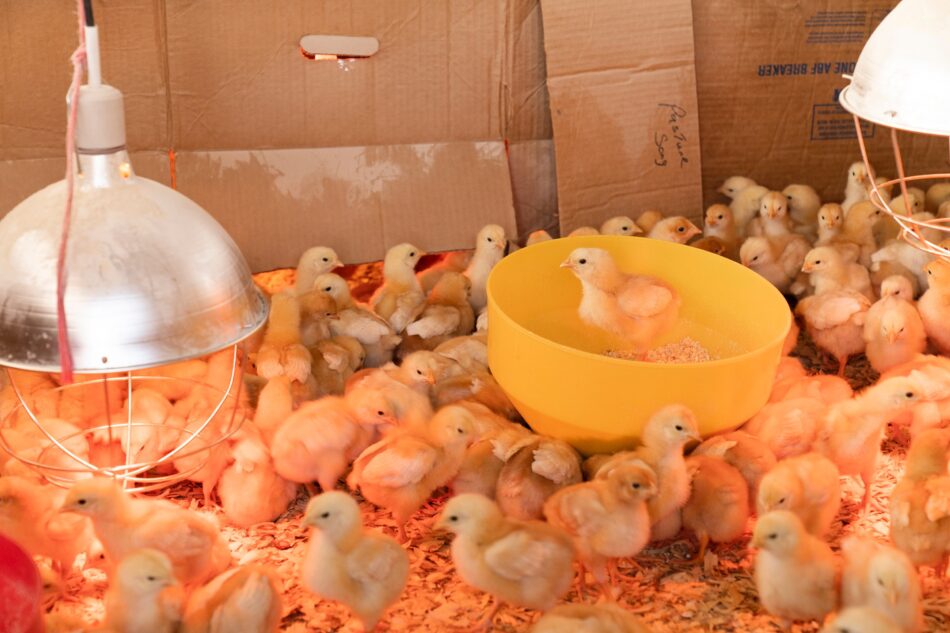
This entry was posted in Chickens on June 2nd, 2021 by alisa.deluca
Pride of Omlet series is a collection of amazing stories which shine the spotlight on extraordinary pets and share their selflessness, bravery, talent and compassion with the world.

We have been lucky enough to collect some wonderful stories of your extraordinary pets and share them with you for 10 weeks! Here is a summary of the stories that you can read again and find directly on our Blog.
Pride of Omlet: Stand Up for Disabled Animals

Jerry’s a cheeky, playful and boisterous rescue dog from Romania who can do a handstand! He landed on his feet when Shena gave him a home and inspired her to start a rescue centre specializing in disabled animals. Read the story here!
Pride of Omlet: The Constant Companion
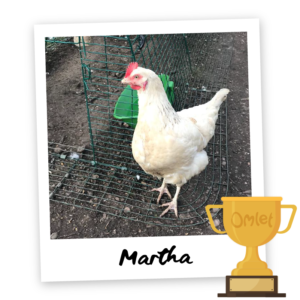
Martha’s humans Nicola and Ben bought chickens to bring joy to Julia, their mother who they cared for at home. The family could never have imagined that a chicken would become a caring companion to Julia in the advanced stages of dementia. Read the story here!
Pride of Omlet: Free Support
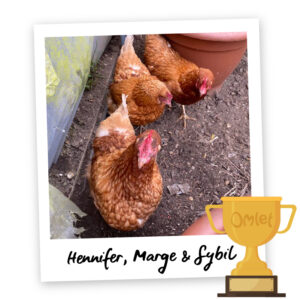
Once caged battery hens, Hennifer Marge and Sybil now work free-range with their human Jonathan, transforming lives for offenders at the Rosemead Project. Jonathan (support worker and chicken champion) believes the hens have the power to unscramble tricky social situations. Read the story here!
Pride of Omlet: A Perfect Match
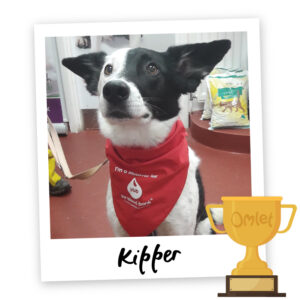
On paper, Kipper wasn’t exactly what Angela wanted. After years of behavioural challenges, he’s become the best-behaved blood donor and saved over forty dog’s lives. Kipper’s turned out to be Angela’s perfect match. Read the story here!
Pride of Omlet: Teachers Pet
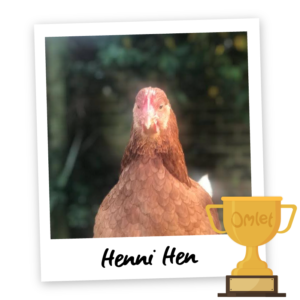
Henni Hen is a teaching assistant by trade. A cute and cuddly chicken who loves children. She follows in the footsteps of her bubbly humans, Hamish and Verity. Read the story here!
Pride of Omlet: Mipit Makes Sense

Mipit is a Mental Health Assistance Dog for his human, Henley. Mipit keeps Henly alive and independent. Who wouldn’t love a dog that can put out your recycling, answer your phone, and be your best friend, come rain or shine? Read the story here!
Pride of Omlet: Perfect Peaky
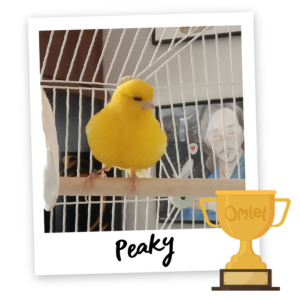
At the tender age of one, Peaky is already a retired filmstar. He had lived in a cage his whole life, released only to perform. When Joana and Fergus took him home, he was a fluffy, yellow bundle of nerves. But they are determined to help Peaky, their cute little canary companion, to come out of his shell. Read the story here!
Pride of Omlet: Saving Sophia’s Life
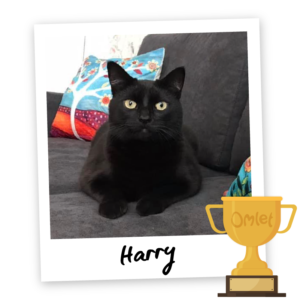
When you’ve grown up with animals, home isn’t home without a pet. Bringing Harry home was lifesaving for both him and his humans, Sarah and daughter Sophia. Harry has a special gift. He’s a unique epilepsy monitor, and he’s saved Sophia’s life countless times. Read the story here!
Pride of Omlet: Buster’s Beard

Buster was destined to chase balls on the beaches of Barry Island. He’s a lovable labradoodle with big brown eyes and a long beard. A thinker with a playful nature, he’s co-authored a children’s book with his human Natalie to bring Autism Awareness to all. Read the story here!
Pride of Omlet: Brave Bunnies

It’s hard to describe how frightened Pixie the rabbit was when the RSPCA rehomed her with an experienced rabbit owner. Eighteen months on, cheeky little Pixie lives in the lap of luxury and is learning to be loved by her adoring human, Wendy. Read the story here!
This entry was posted in Pets on June 1st, 2021 by alisa.deluca
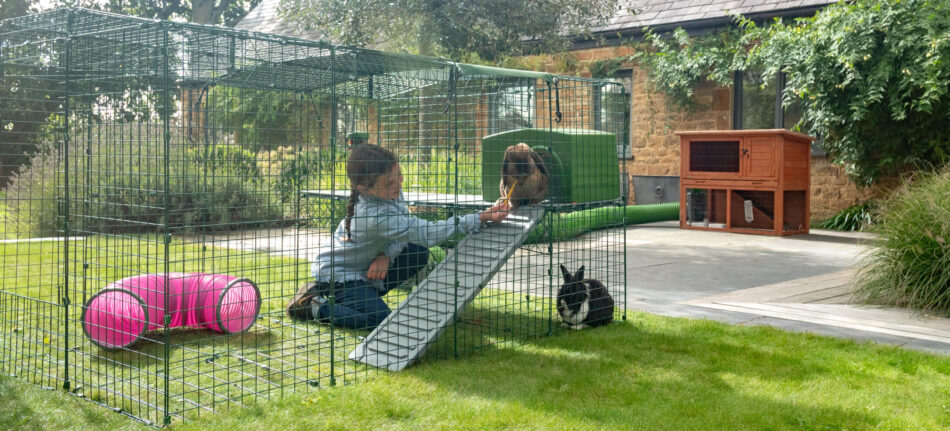
Rabbits that bond with their owners live longer, happier lives. Learning how to build a bond with your bunnies helps you enjoy their company even more, and forges a friendship that’ll span their entire lives. Since rabbits are prey animals, they have an innate nervous nature – and as a result, don’t give their trust as easily as dogs or cats may. But, with some patience, you and your rabbits will be able to understand each other better, deepening the bond between you. Whether you’re a first-time rabbit owner or a seasoned bunny keeper, here are 10 ways to bond with your rabbits.
1. Learn their personalities
Like humans, rabbits have their own distinct personalities and characteristics that set them apart from each other. Some rabbits are very shy when they’re first brought home, while others are outgoing and social from the start. Learning to read your rabbits’ body language is the first step in figuring out their unique personalities. Rabbits make different sounds and change their posture to reflect how they’re feeling. You may also find that you have two rabbits with completely different personalities toward humans – but having an outgoing rabbit can be helpful in gaining the trust of a more timid bunny.
2. Create a shared space
It’s natural for your rabbits to feel nervous or even defensive if you interact with them by reaching into their hutch – after all, this space is their home, and all of their instincts tell them to protect it from potential predators. If you want to spend time bonding with your rabbits, try setting up a play area or run large enough for you to sit inside with your pets. This way, you can start interacting with them on neutral ground. Rabbits feel comfortable when they have something over their heads, so don’t feel bad if the first few times they hide under any covered area you have set up.
While all bunnies should have a comfortable rabbit hutch, your first few interactions shouldn’t be inside of it. Rabbits seek shelter in the form of burrows or dens, which is how they see their hutch. Reaching into the hutch to pick up or pet your new rabbits can startle them, and can eventually create unease inside their safe space.
Instead of infiltrating their hutch, create a shared space in the form of a rabbit playpen. This will enable you to sit inside of an open area to let your rabbits come to you. Don’t be discouraged if your bunnies dart to the nearest cover during your first few attempts to pet them – this is their natural instinct shining through.
3. Offer healthy treats
While sitting in your shared space, offer your rabbits healthy treats by hand. There are plenty of fresh foods that you can feed your rabbits that will go a long way in winning their trust. Leafy greens in particular are both nutritious and easy to offer by hand – their length can be adjusted, gradually luring your rabbits toward you.
Once your rabbits are taking treats by hand, slowly encourage them to hop onto your extended legs or lap. While sitting on the ground, place the treats on your leg or hold them just over your lap. Before long, your bunnies will be bounding into your lap for food and attention.
4. Fill the playpen with toys
Placing more than just yourself inside of the shared space with your bunnies will help them adjust even faster to your presence. Bunnies love burrows, hideaways, and differing heights to gain a new vantage point. Adding Zippi Rabbit Tunnels, Zippi Rabbit Platforms, or Zippi Rabbit Shelters and Play Tunnels are all great accessories to help your bunnies feel more at ease and encourage play. It’s a good sign when your rabbits play while you’re in a shared space – it means they trust you enough to venture out of safety and exhibit their natural behaviours.
5. Give your rabbit new experiences
Rabbits are creatures of habit, but it’s good to change things up from time to time. New foods, toys, or run accessories are fresh and fun ways to break up monotony. And, over time, your rabbits will learn to associate you with these fun additions or changes to their routines. Try rearranging their run, re-routing or adding onto their Zippi Tunnel System, or offering homemade toys like empty paper towel rolls to brighten your bunnies’ day.
6. Petting your rabbit
Once your rabbits are comfortable sharing a space and taking treats from you, it’s time to introduce petting. Physical contact builds a stronger bond between you and your bunnies, but they may not take to it at first. The first time you stroke your rabbits, they may become startled and dart for cover. This too is a natural behavior– one that can be minimized over time. It can take several weeks to be able to pet your rabbits without this reaction.
The best way to introduce petting to your rabbits is to hold your hand low, just to the side of their heads. This way, they’ll be able to see exactly who and what is coming toward them. If you come straight from above their heads and backs, they can’t see what’s coming and will react just like their cousins in the wild running from a bird of prey or other predator. Also, avoid approaching your rabbit directly in front of their heads – they have a “blind spot” due to the location of their eyes, and are unable to see things coming toward their foreheads.
7. Teach your rabbits tricks
After your rabbits have adjusted to being petted, you can start incorporating some intellectual stimulation. Teaching your rabbits tricks will build their confidence, your bond with them, and foster their natural curiosity and behaviours. Start with simple tricks that come naturally to them, like walking through a tunnel or up a ramp with a treat waiting for them at the end. You can slowly build up to more advanced tricks like spinning in a cycle or rolling over. Rabbits can even be taught to play fetch like a dog.
8. Copying your rabbit
This method may seem unusual, but the goal is to behave in ways that your bunnies would expect from others of their own species. This could be you pretending to clean your “paws”, or leaning over to pretend to nibble at some of their food. Make sure you have your rabbits’ rapt attention, otherwise, you’ll be playing bunny charades by yourself. This method is particularly fun for children, especially those who aren’t old enough to have an abundance of patience to wait for their bunnies to come to them.
9. Choose the right time to play with your rabbit
As you observe your rabbits, you’ll see a pattern in their daily routine. There will be times of the day when they’re most active, when they prefer to nap, and when they seek out food or water. Learning their routine will help you determine the best time to play and socialize with them. Choose a time of day when they are most active – this will be the time when rabbits will be most receptive to play and training endeavours.
10. Learning to hold your rabbit safely
The last step in bonding with your rabbits is holding them. It may be tempting to push this step toward the top of the list, but it’s important not to rush them. Being held is the ultimate submission to humans – the truest expression of trust for a rabbit.
Always hold your rabbits in a way that’s most comfortable for them. This may be in a football hold, with your rabbit’s head tucked under your arm, or supported snugly against your body. Some rabbits even prefer being held on their backs – similar to how we hold human babies. Always be sure to support their hindquarters to help them feel secure.
Omlet and your rabbits
Rabbits are gentle animals, and need gentleness in return. Being respectful of your rabbits’ space, personalities, and insecurities will help them see you as a friend instead of a foe. Starting them out in an Eglu Go Rabbit Hutch will begin building the bond between you and your bunnies with confidence and security. And, when you add a Zippi Rabbit Playpen, you’ll be able to cultivate a lasting relationship in a shared space that you can customize and tailor to your rabbits’ needs throughout your lasting relationship.

This entry was posted in Pets on June 1st, 2021 by alisa.deluca















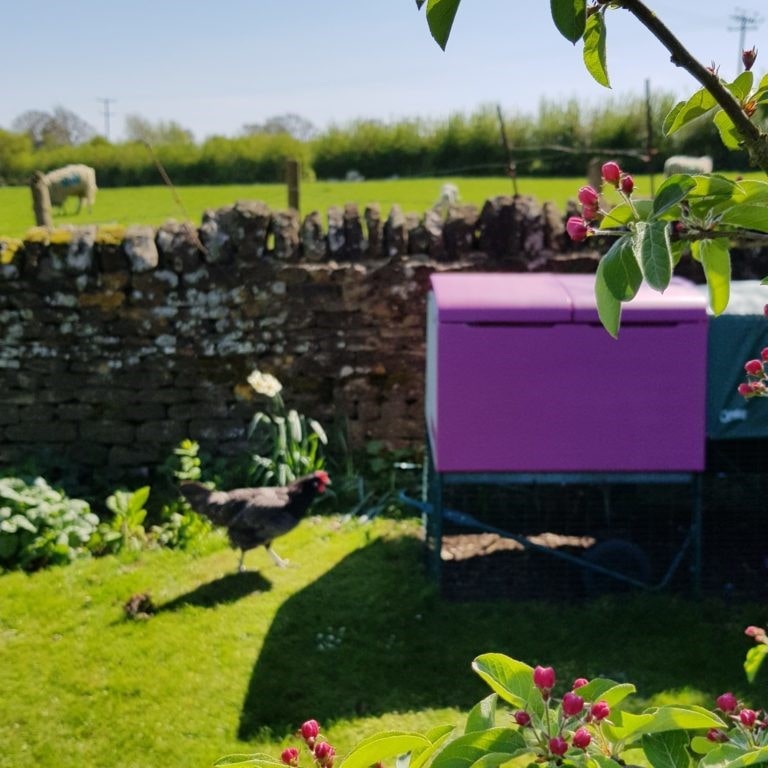

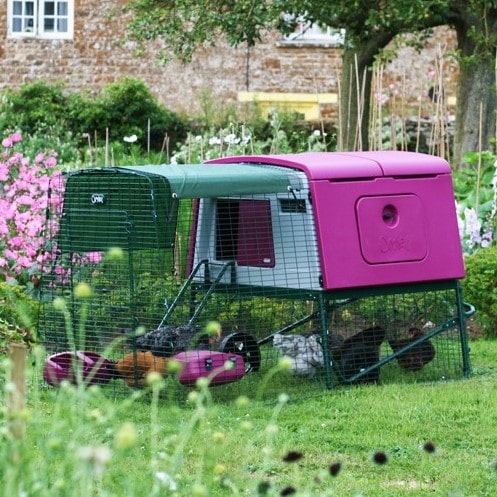


 A dog who has been taught positive behaviour will be your best friend – fun, affectionate and reliable. It’s straightforward teaching your dog this canine version of positive thinking, but it won’t happen unless you lead the way.
A dog who has been taught positive behaviour will be your best friend – fun, affectionate and reliable. It’s straightforward teaching your dog this canine version of positive thinking, but it won’t happen unless you lead the way. 2. Affection
2. Affection 4. A trip to a favourite place
4. A trip to a favourite place 1. Keep it simple
1. Keep it simple 3. Quality time
3. Quality time














